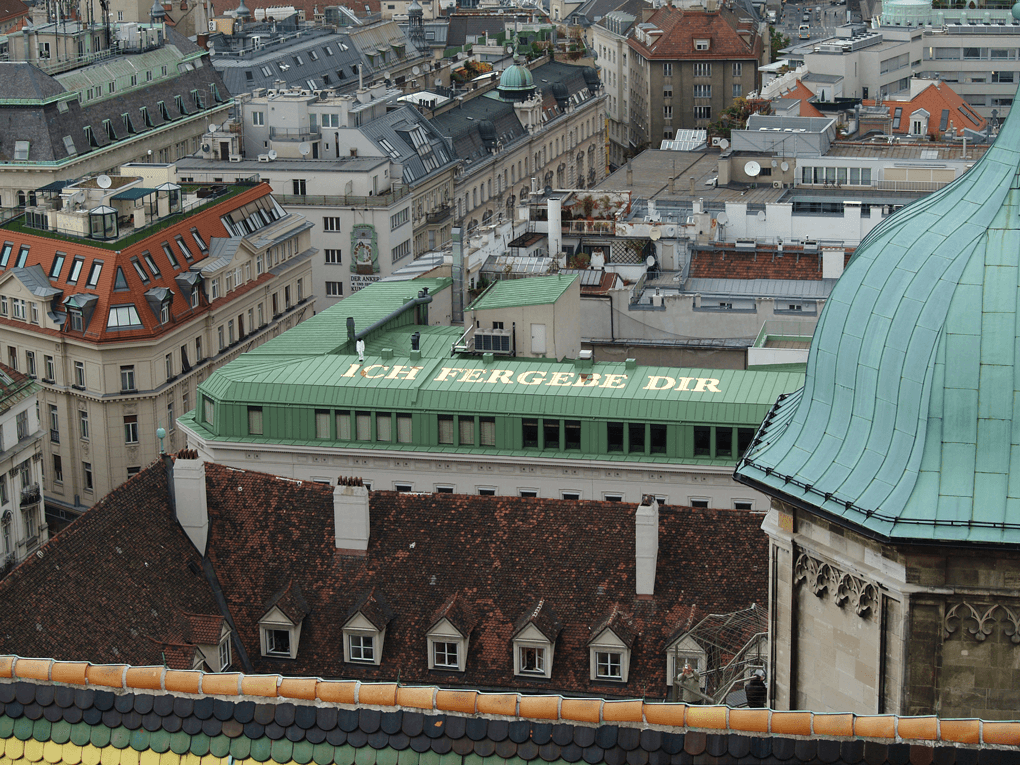
Ich fergebe dir, intervention
in public space, das weisse haus, Vienna 2009

Ich fergebe dir, intervention
in public space, das weisse haus, Vienna 2009

Ich fergebe dir, intervention
in public space, das weisse haus, Vienna 2009
ICH
FERGEBE DIR (I forgife you)
Intervention
in public space, das weisse haus, Vienna 2009
Michail Michailov’s 30 meter long lettering "ICH
FERGEBE DIR" (which means
"I FORGIFE YOU") sounds ambiguous. The written wording in front of a national symbol of Austria, the St. Stephans Cathedral, affects every steeple-visitor and makes him/her aware of his personhood, shifting his focus from his outward observations - as a tourist - to his own inward mental state. The writing transgresses the typical Ego-It perspective while establishing an Ego-You relationship. The "ICH" (which means I) and the "DIR" (which means you) stands for the personalities, which are in dialogue. It evokes confusion and concern at the same time. Who is the "I", which forgives? Who is forgiven? Whom do I want to forgive? It’s also a straight message to the Church and the State. The countless obstacles, which are put in a foreign national’s, an artist’s, an unusual person’s way, are commemorated and "forgiven".
The misspelled word "fergeben" (which is correctly written "vergeben") is not in line with the perfect first district. The "wrong-F" implicates not-being-perfect, not-being-in-line and not-completely belonging-to. It stands for the socio-cultural differences and questions the society’s pursuit of perfection.
To satisfy the first district’s aesthetics, the words are lettered in gold. Because of the reflecting letters the writing alters in intensity and colour, depending on weather and lighting conditions: from scarcely visible to black and luminously golden. Whether you are "fergeben (which means forgiven, again misspelled with an f instead of a v)" or not, also becomes a question of the weather. Thus, "ICH FERGEBE DIR" is chameleon-like, seems vivid and can only be read from the main church belltower or the main spire of the St.Stephans Cathedral.
"I FORGIFE YOU") sounds ambiguous. The written wording in front of a national symbol of Austria, the St. Stephans Cathedral, affects every steeple-visitor and makes him/her aware of his personhood, shifting his focus from his outward observations - as a tourist - to his own inward mental state. The writing transgresses the typical Ego-It perspective while establishing an Ego-You relationship. The "ICH" (which means I) and the "DIR" (which means you) stands for the personalities, which are in dialogue. It evokes confusion and concern at the same time. Who is the "I", which forgives? Who is forgiven? Whom do I want to forgive? It’s also a straight message to the Church and the State. The countless obstacles, which are put in a foreign national’s, an artist’s, an unusual person’s way, are commemorated and "forgiven".
The misspelled word "fergeben" (which is correctly written "vergeben") is not in line with the perfect first district. The "wrong-F" implicates not-being-perfect, not-being-in-line and not-completely belonging-to. It stands for the socio-cultural differences and questions the society’s pursuit of perfection.
To satisfy the first district’s aesthetics, the words are lettered in gold. Because of the reflecting letters the writing alters in intensity and colour, depending on weather and lighting conditions: from scarcely visible to black and luminously golden. Whether you are "fergeben (which means forgiven, again misspelled with an f instead of a v)" or not, also becomes a question of the weather. Thus, "ICH FERGEBE DIR" is chameleon-like, seems vivid and can only be read from the main church belltower or the main spire of the St.Stephans Cathedral.